WRKE 5001: Final Work Placement Project - Healthcare Insights
VerifiedAdded on 2023/01/09
|26
|5050
|70
Project
AI Summary
This work placement project, in lieu of a traditional placement, delves into the complexities of the Ontario healthcare system. It encompasses a comprehensive analysis of primary care reforms, examining the evolution from fee-for-service models to current practices, and assessing the impact on both physicians and patients. The project incorporates interviews with healthcare professionals and patients from diverse backgrounds, including individuals from different cultures, to gather varied perspectives on healthcare access, quality, and experiences. A significant component involves a comparative analysis of healthcare systems, contrasting the Canadian model with that of another country, highlighting similarities, differences, and potential areas for improvement. The project extends to a practical application, where the student evaluates existing healthcare office layouts and designs an ideal office environment, considering factors such as patient flow, safety, and comfort. Furthermore, the project adheres to ethical considerations, including patient confidentiality and compliance with privacy laws like PHIPA, ensuring all interviewees provide informed consent. The final report presents findings, analyses, and recommendations, providing a holistic view of the healthcare landscape and contributing to a deeper understanding of its challenges and opportunities.
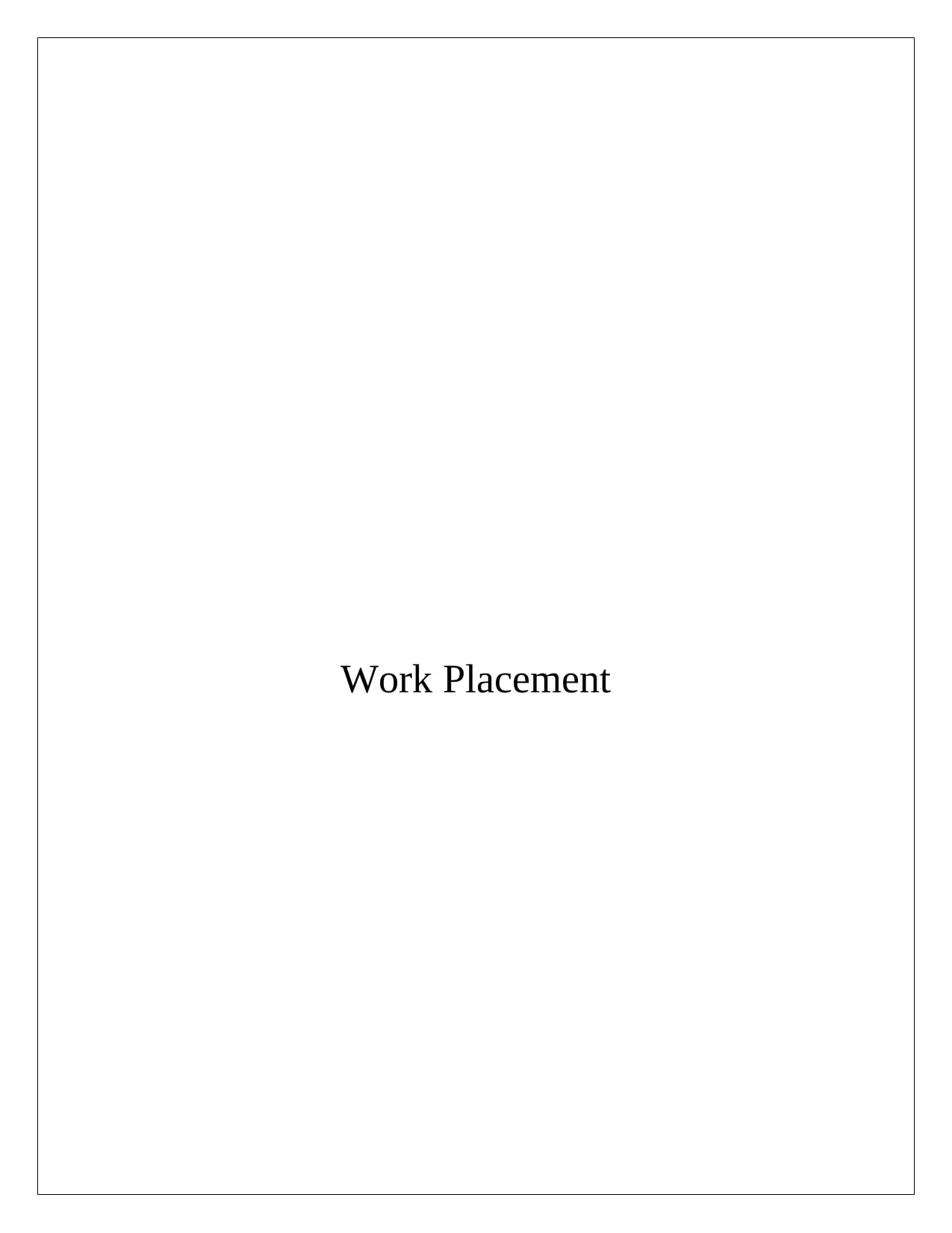
Work Placement
Paraphrase This Document
Need a fresh take? Get an instant paraphrase of this document with our AI Paraphraser
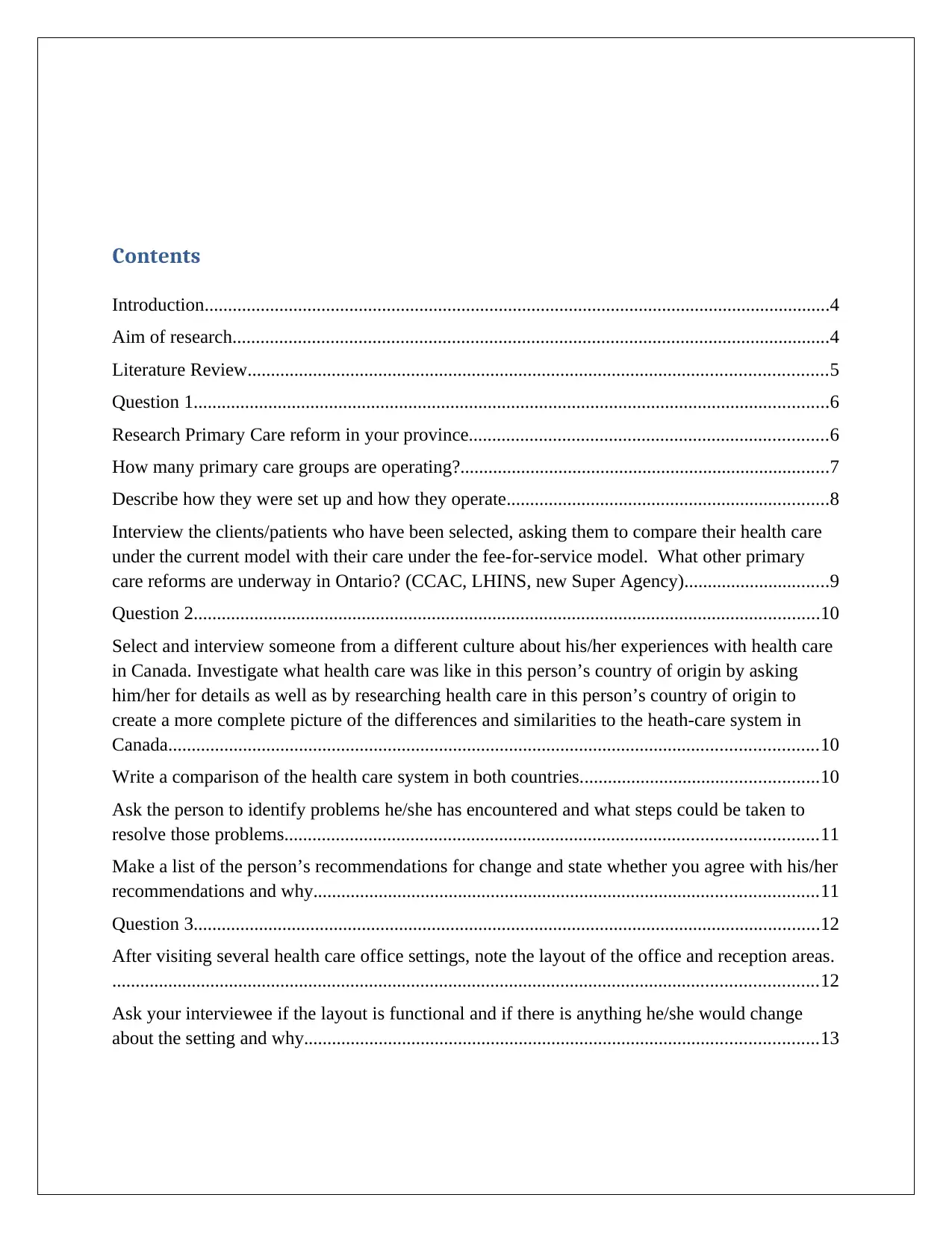
Contents
Introduction......................................................................................................................................4
Aim of research................................................................................................................................4
Literature Review............................................................................................................................5
Question 1........................................................................................................................................6
Research Primary Care reform in your province.............................................................................6
How many primary care groups are operating?...............................................................................7
Describe how they were set up and how they operate.....................................................................8
Interview the clients/patients who have been selected, asking them to compare their health care
under the current model with their care under the fee-for-service model. What other primary
care reforms are underway in Ontario? (CCAC, LHINS, new Super Agency)...............................9
Question 2......................................................................................................................................10
Select and interview someone from a different culture about his/her experiences with health care
in Canada. Investigate what health care was like in this person’s country of origin by asking
him/her for details as well as by researching health care in this person’s country of origin to
create a more complete picture of the differences and similarities to the heath-care system in
Canada...........................................................................................................................................10
Write a comparison of the health care system in both countries...................................................10
Ask the person to identify problems he/she has encountered and what steps could be taken to
resolve those problems..................................................................................................................11
Make a list of the person’s recommendations for change and state whether you agree with his/her
recommendations and why............................................................................................................11
Question 3......................................................................................................................................12
After visiting several health care office settings, note the layout of the office and reception areas.
.......................................................................................................................................................12
Ask your interviewee if the layout is functional and if there is anything he/she would change
about the setting and why..............................................................................................................13
Introduction......................................................................................................................................4
Aim of research................................................................................................................................4
Literature Review............................................................................................................................5
Question 1........................................................................................................................................6
Research Primary Care reform in your province.............................................................................6
How many primary care groups are operating?...............................................................................7
Describe how they were set up and how they operate.....................................................................8
Interview the clients/patients who have been selected, asking them to compare their health care
under the current model with their care under the fee-for-service model. What other primary
care reforms are underway in Ontario? (CCAC, LHINS, new Super Agency)...............................9
Question 2......................................................................................................................................10
Select and interview someone from a different culture about his/her experiences with health care
in Canada. Investigate what health care was like in this person’s country of origin by asking
him/her for details as well as by researching health care in this person’s country of origin to
create a more complete picture of the differences and similarities to the heath-care system in
Canada...........................................................................................................................................10
Write a comparison of the health care system in both countries...................................................10
Ask the person to identify problems he/she has encountered and what steps could be taken to
resolve those problems..................................................................................................................11
Make a list of the person’s recommendations for change and state whether you agree with his/her
recommendations and why............................................................................................................11
Question 3......................................................................................................................................12
After visiting several health care office settings, note the layout of the office and reception areas.
.......................................................................................................................................................12
Ask your interviewee if the layout is functional and if there is anything he/she would change
about the setting and why..............................................................................................................13
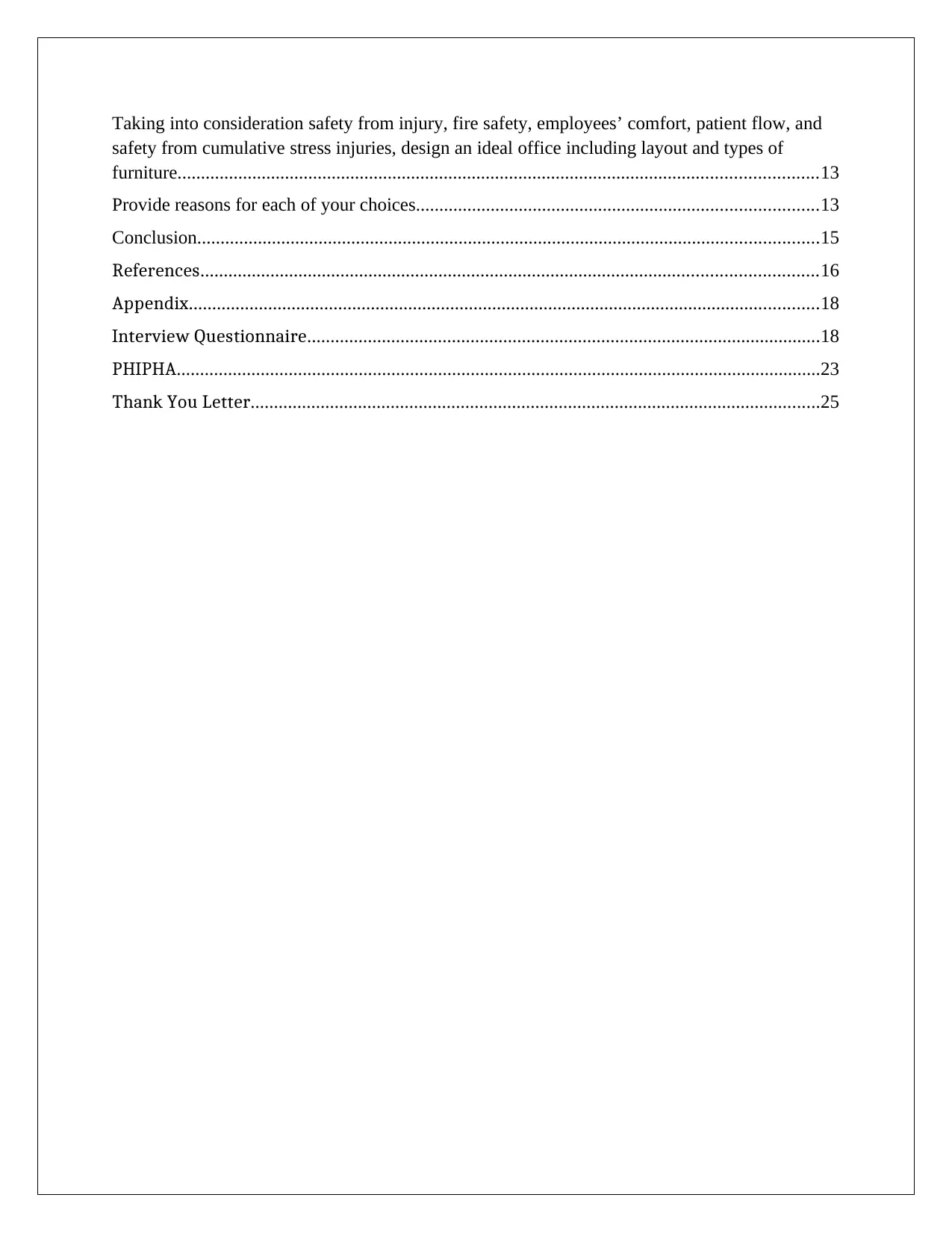
Taking into consideration safety from injury, fire safety, employees’ comfort, patient flow, and
safety from cumulative stress injuries, design an ideal office including layout and types of
furniture.........................................................................................................................................13
Provide reasons for each of your choices......................................................................................13
Conclusion.....................................................................................................................................15
References....................................................................................................................................16
Appendix.......................................................................................................................................18
Interview Questionnaire..............................................................................................................18
PHIPHA..........................................................................................................................................23
Thank You Letter..........................................................................................................................25
safety from cumulative stress injuries, design an ideal office including layout and types of
furniture.........................................................................................................................................13
Provide reasons for each of your choices......................................................................................13
Conclusion.....................................................................................................................................15
References....................................................................................................................................16
Appendix.......................................................................................................................................18
Interview Questionnaire..............................................................................................................18
PHIPHA..........................................................................................................................................23
Thank You Letter..........................................................................................................................25
⊘ This is a preview!⊘
Do you want full access?
Subscribe today to unlock all pages.

Trusted by 1+ million students worldwide
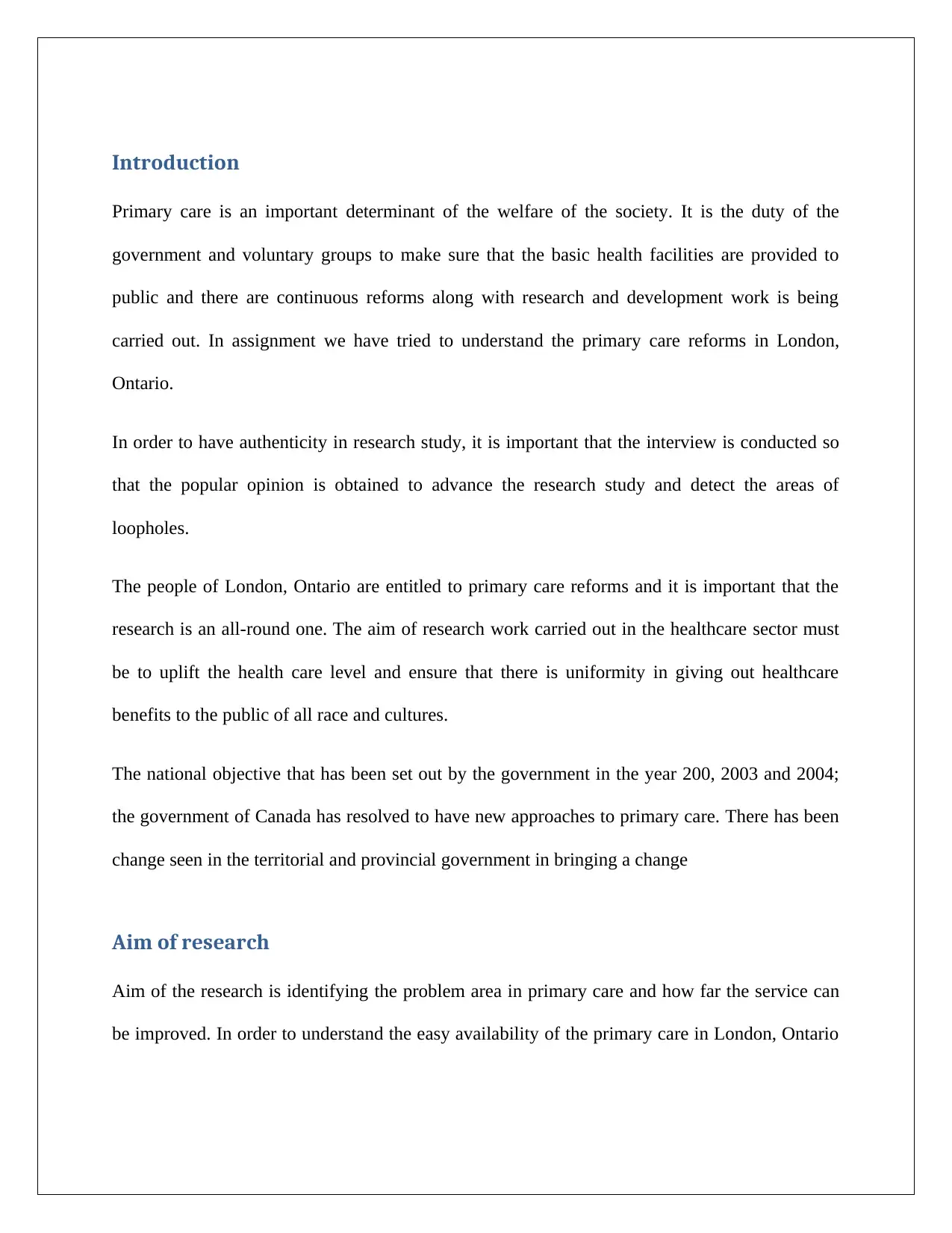
Introduction
Primary care is an important determinant of the welfare of the society. It is the duty of the
government and voluntary groups to make sure that the basic health facilities are provided to
public and there are continuous reforms along with research and development work is being
carried out. In assignment we have tried to understand the primary care reforms in London,
Ontario.
In order to have authenticity in research study, it is important that the interview is conducted so
that the popular opinion is obtained to advance the research study and detect the areas of
loopholes.
The people of London, Ontario are entitled to primary care reforms and it is important that the
research is an all-round one. The aim of research work carried out in the healthcare sector must
be to uplift the health care level and ensure that there is uniformity in giving out healthcare
benefits to the public of all race and cultures.
The national objective that has been set out by the government in the year 200, 2003 and 2004;
the government of Canada has resolved to have new approaches to primary care. There has been
change seen in the territorial and provincial government in bringing a change
Aim of research
Aim of the research is identifying the problem area in primary care and how far the service can
be improved. In order to understand the easy availability of the primary care in London, Ontario
Primary care is an important determinant of the welfare of the society. It is the duty of the
government and voluntary groups to make sure that the basic health facilities are provided to
public and there are continuous reforms along with research and development work is being
carried out. In assignment we have tried to understand the primary care reforms in London,
Ontario.
In order to have authenticity in research study, it is important that the interview is conducted so
that the popular opinion is obtained to advance the research study and detect the areas of
loopholes.
The people of London, Ontario are entitled to primary care reforms and it is important that the
research is an all-round one. The aim of research work carried out in the healthcare sector must
be to uplift the health care level and ensure that there is uniformity in giving out healthcare
benefits to the public of all race and cultures.
The national objective that has been set out by the government in the year 200, 2003 and 2004;
the government of Canada has resolved to have new approaches to primary care. There has been
change seen in the territorial and provincial government in bringing a change
Aim of research
Aim of the research is identifying the problem area in primary care and how far the service can
be improved. In order to understand the easy availability of the primary care in London, Ontario
Paraphrase This Document
Need a fresh take? Get an instant paraphrase of this document with our AI Paraphraser
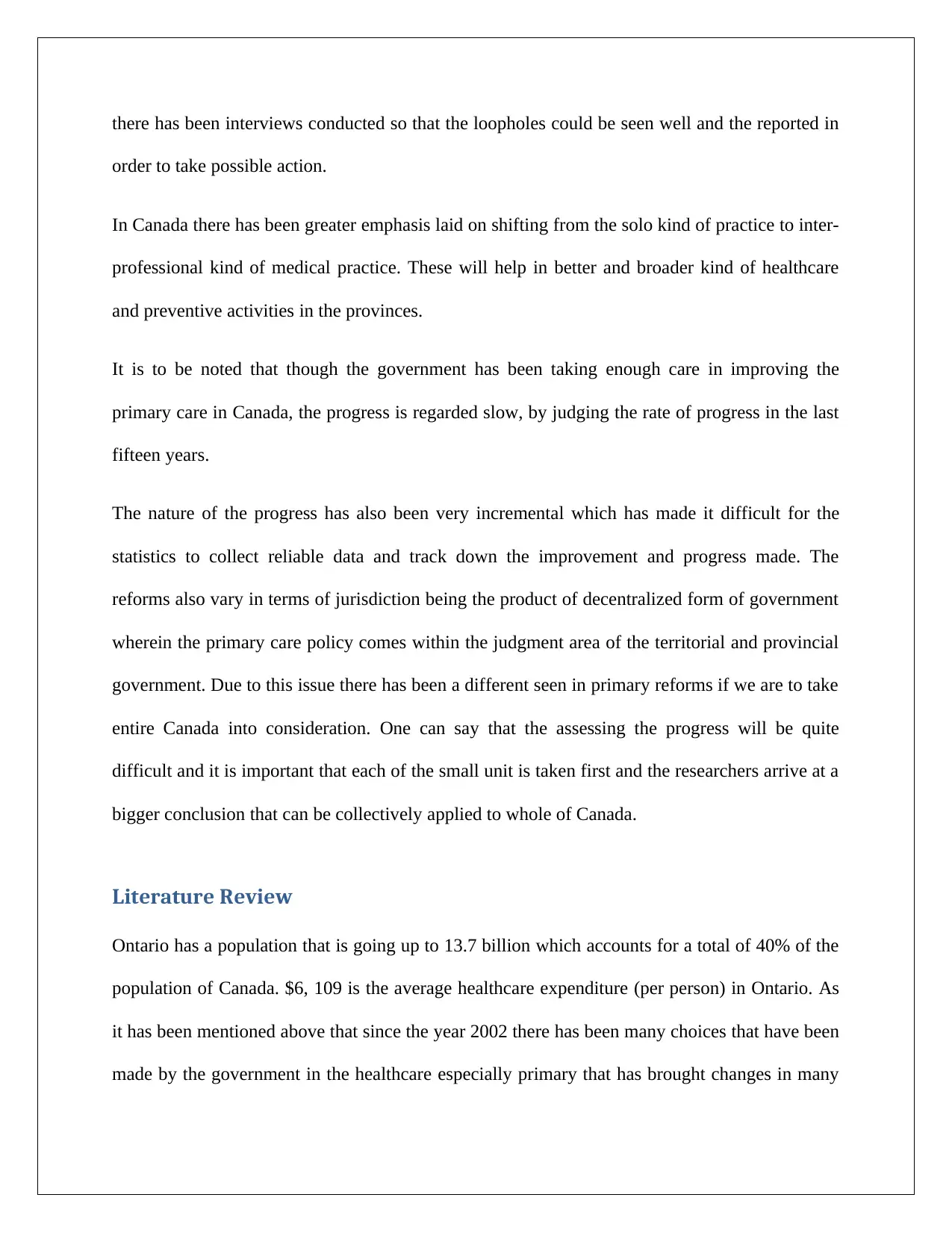
there has been interviews conducted so that the loopholes could be seen well and the reported in
order to take possible action.
In Canada there has been greater emphasis laid on shifting from the solo kind of practice to inter-
professional kind of medical practice. These will help in better and broader kind of healthcare
and preventive activities in the provinces.
It is to be noted that though the government has been taking enough care in improving the
primary care in Canada, the progress is regarded slow, by judging the rate of progress in the last
fifteen years.
The nature of the progress has also been very incremental which has made it difficult for the
statistics to collect reliable data and track down the improvement and progress made. The
reforms also vary in terms of jurisdiction being the product of decentralized form of government
wherein the primary care policy comes within the judgment area of the territorial and provincial
government. Due to this issue there has been a different seen in primary reforms if we are to take
entire Canada into consideration. One can say that the assessing the progress will be quite
difficult and it is important that each of the small unit is taken first and the researchers arrive at a
bigger conclusion that can be collectively applied to whole of Canada.
Literature Review
Ontario has a population that is going up to 13.7 billion which accounts for a total of 40% of the
population of Canada. $6, 109 is the average healthcare expenditure (per person) in Ontario. As
it has been mentioned above that since the year 2002 there has been many choices that have been
made by the government in the healthcare especially primary that has brought changes in many
order to take possible action.
In Canada there has been greater emphasis laid on shifting from the solo kind of practice to inter-
professional kind of medical practice. These will help in better and broader kind of healthcare
and preventive activities in the provinces.
It is to be noted that though the government has been taking enough care in improving the
primary care in Canada, the progress is regarded slow, by judging the rate of progress in the last
fifteen years.
The nature of the progress has also been very incremental which has made it difficult for the
statistics to collect reliable data and track down the improvement and progress made. The
reforms also vary in terms of jurisdiction being the product of decentralized form of government
wherein the primary care policy comes within the judgment area of the territorial and provincial
government. Due to this issue there has been a different seen in primary reforms if we are to take
entire Canada into consideration. One can say that the assessing the progress will be quite
difficult and it is important that each of the small unit is taken first and the researchers arrive at a
bigger conclusion that can be collectively applied to whole of Canada.
Literature Review
Ontario has a population that is going up to 13.7 billion which accounts for a total of 40% of the
population of Canada. $6, 109 is the average healthcare expenditure (per person) in Ontario. As
it has been mentioned above that since the year 2002 there has been many choices that have been
made by the government in the healthcare especially primary that has brought changes in many
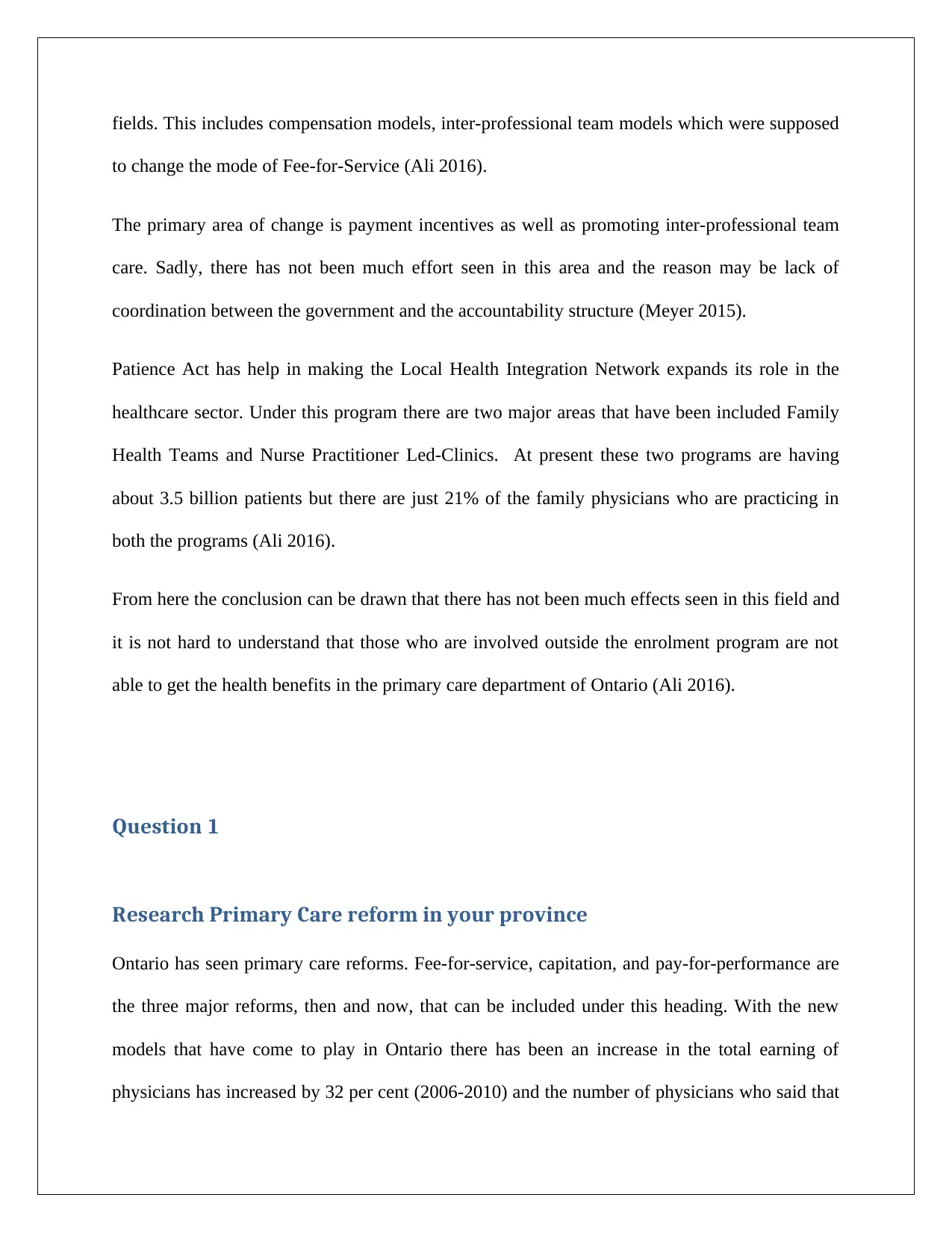
fields. This includes compensation models, inter-professional team models which were supposed
to change the mode of Fee-for-Service (Ali 2016).
The primary area of change is payment incentives as well as promoting inter-professional team
care. Sadly, there has not been much effort seen in this area and the reason may be lack of
coordination between the government and the accountability structure (Meyer 2015).
Patience Act has help in making the Local Health Integration Network expands its role in the
healthcare sector. Under this program there are two major areas that have been included Family
Health Teams and Nurse Practitioner Led-Clinics. At present these two programs are having
about 3.5 billion patients but there are just 21% of the family physicians who are practicing in
both the programs (Ali 2016).
From here the conclusion can be drawn that there has not been much effects seen in this field and
it is not hard to understand that those who are involved outside the enrolment program are not
able to get the health benefits in the primary care department of Ontario (Ali 2016).
Question 1
Research Primary Care reform in your province
Ontario has seen primary care reforms. Fee-for-service, capitation, and pay-for-performance are
the three major reforms, then and now, that can be included under this heading. With the new
models that have come to play in Ontario there has been an increase in the total earning of
physicians has increased by 32 per cent (2006-2010) and the number of physicians who said that
to change the mode of Fee-for-Service (Ali 2016).
The primary area of change is payment incentives as well as promoting inter-professional team
care. Sadly, there has not been much effort seen in this area and the reason may be lack of
coordination between the government and the accountability structure (Meyer 2015).
Patience Act has help in making the Local Health Integration Network expands its role in the
healthcare sector. Under this program there are two major areas that have been included Family
Health Teams and Nurse Practitioner Led-Clinics. At present these two programs are having
about 3.5 billion patients but there are just 21% of the family physicians who are practicing in
both the programs (Ali 2016).
From here the conclusion can be drawn that there has not been much effects seen in this field and
it is not hard to understand that those who are involved outside the enrolment program are not
able to get the health benefits in the primary care department of Ontario (Ali 2016).
Question 1
Research Primary Care reform in your province
Ontario has seen primary care reforms. Fee-for-service, capitation, and pay-for-performance are
the three major reforms, then and now, that can be included under this heading. With the new
models that have come to play in Ontario there has been an increase in the total earning of
physicians has increased by 32 per cent (2006-2010) and the number of physicians who said that
⊘ This is a preview!⊘
Do you want full access?
Subscribe today to unlock all pages.

Trusted by 1+ million students worldwide
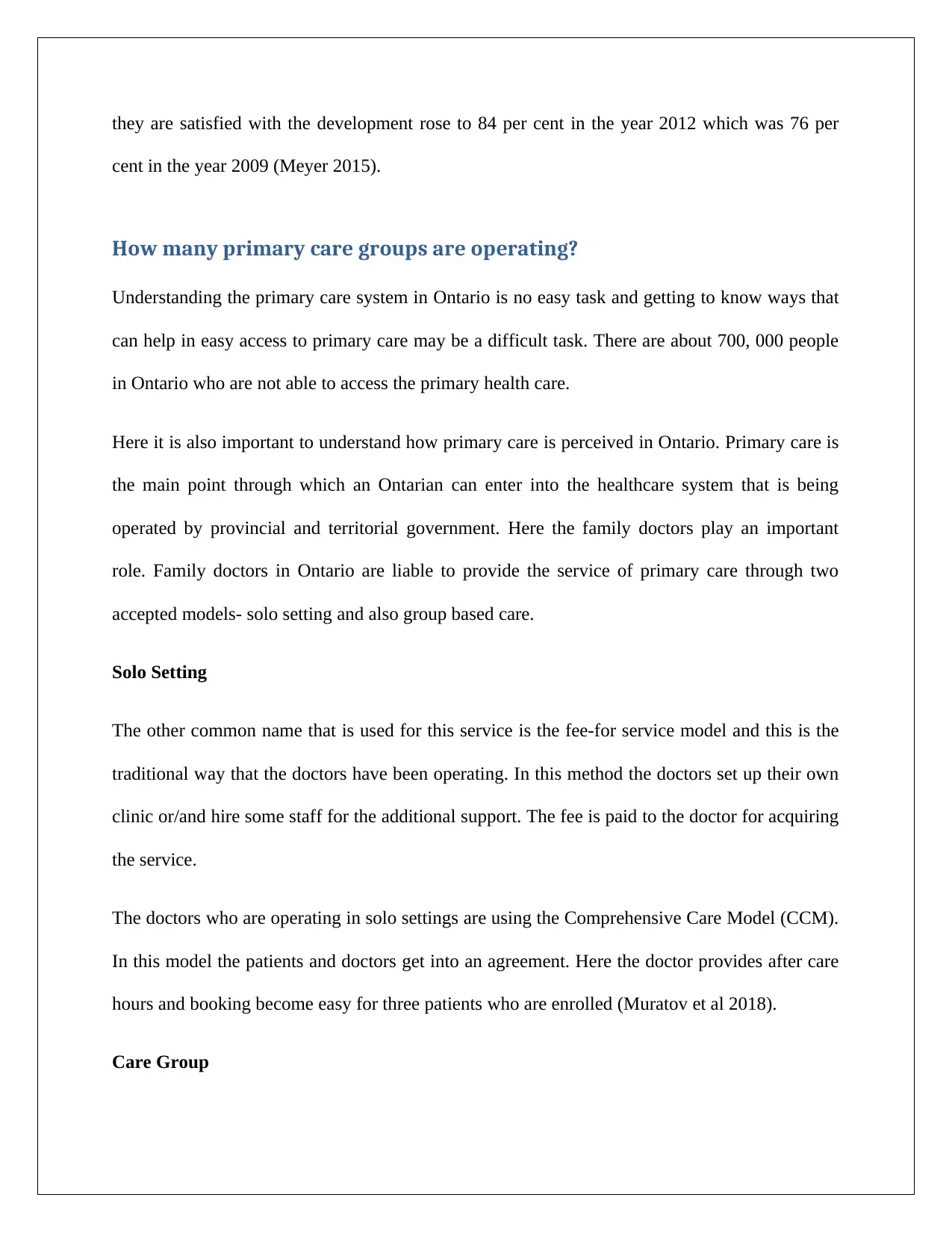
they are satisfied with the development rose to 84 per cent in the year 2012 which was 76 per
cent in the year 2009 (Meyer 2015).
How many primary care groups are operating?
Understanding the primary care system in Ontario is no easy task and getting to know ways that
can help in easy access to primary care may be a difficult task. There are about 700, 000 people
in Ontario who are not able to access the primary health care.
Here it is also important to understand how primary care is perceived in Ontario. Primary care is
the main point through which an Ontarian can enter into the healthcare system that is being
operated by provincial and territorial government. Here the family doctors play an important
role. Family doctors in Ontario are liable to provide the service of primary care through two
accepted models- solo setting and also group based care.
Solo Setting
The other common name that is used for this service is the fee-for service model and this is the
traditional way that the doctors have been operating. In this method the doctors set up their own
clinic or/and hire some staff for the additional support. The fee is paid to the doctor for acquiring
the service.
The doctors who are operating in solo settings are using the Comprehensive Care Model (CCM).
In this model the patients and doctors get into an agreement. Here the doctor provides after care
hours and booking become easy for three patients who are enrolled (Muratov et al 2018).
Care Group
cent in the year 2009 (Meyer 2015).
How many primary care groups are operating?
Understanding the primary care system in Ontario is no easy task and getting to know ways that
can help in easy access to primary care may be a difficult task. There are about 700, 000 people
in Ontario who are not able to access the primary health care.
Here it is also important to understand how primary care is perceived in Ontario. Primary care is
the main point through which an Ontarian can enter into the healthcare system that is being
operated by provincial and territorial government. Here the family doctors play an important
role. Family doctors in Ontario are liable to provide the service of primary care through two
accepted models- solo setting and also group based care.
Solo Setting
The other common name that is used for this service is the fee-for service model and this is the
traditional way that the doctors have been operating. In this method the doctors set up their own
clinic or/and hire some staff for the additional support. The fee is paid to the doctor for acquiring
the service.
The doctors who are operating in solo settings are using the Comprehensive Care Model (CCM).
In this model the patients and doctors get into an agreement. Here the doctor provides after care
hours and booking become easy for three patients who are enrolled (Muratov et al 2018).
Care Group
Paraphrase This Document
Need a fresh take? Get an instant paraphrase of this document with our AI Paraphraser
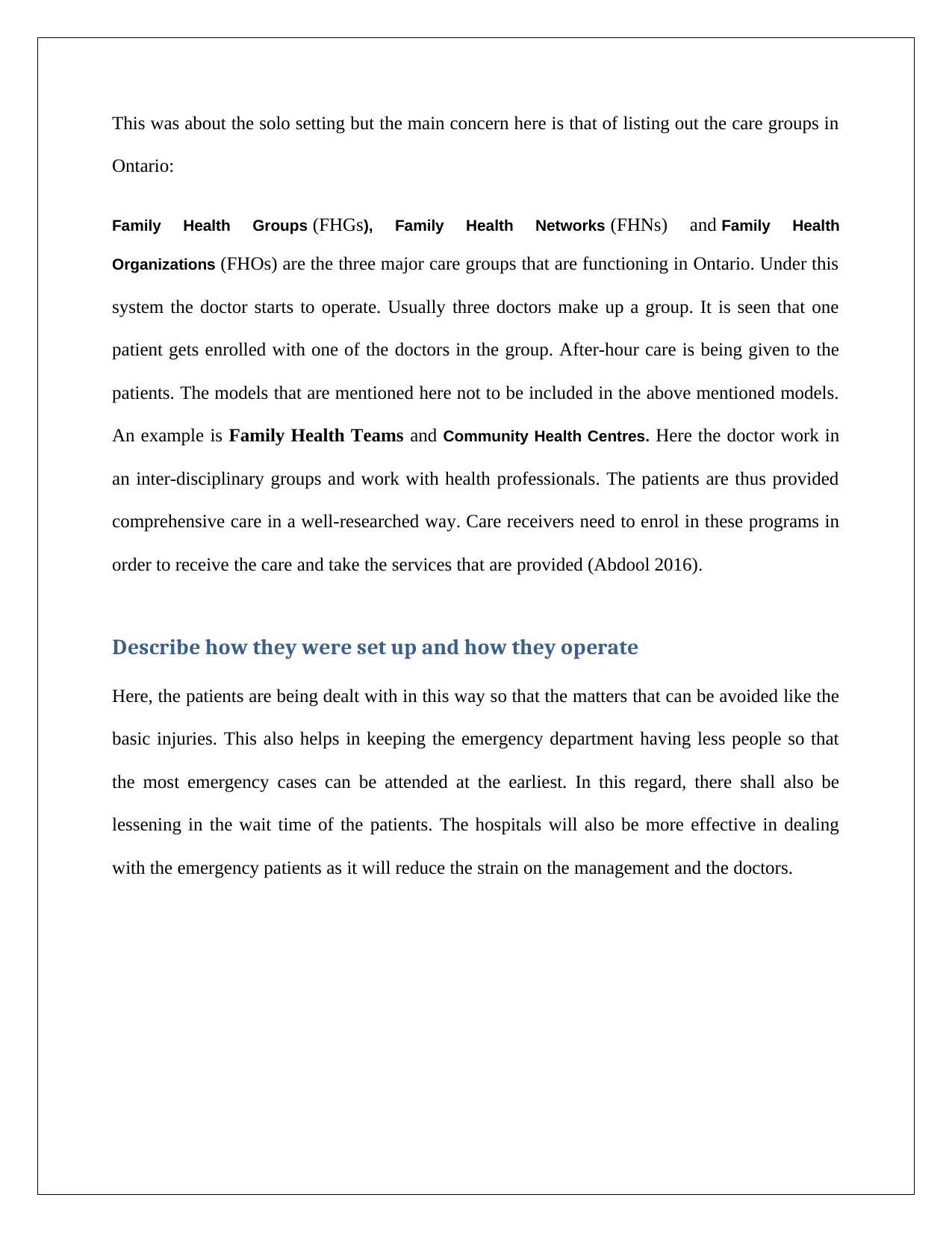
This was about the solo setting but the main concern here is that of listing out the care groups in
Ontario:
Family Health Groups (FHGs), Family Health Networks (FHNs) and Family Health
Organizations (FHOs) are the three major care groups that are functioning in Ontario. Under this
system the doctor starts to operate. Usually three doctors make up a group. It is seen that one
patient gets enrolled with one of the doctors in the group. After-hour care is being given to the
patients. The models that are mentioned here not to be included in the above mentioned models.
An example is Family Health Teams and Community Health Centres. Here the doctor work in
an inter-disciplinary groups and work with health professionals. The patients are thus provided
comprehensive care in a well-researched way. Care receivers need to enrol in these programs in
order to receive the care and take the services that are provided (Abdool 2016).
Describe how they were set up and how they operate
Here, the patients are being dealt with in this way so that the matters that can be avoided like the
basic injuries. This also helps in keeping the emergency department having less people so that
the most emergency cases can be attended at the earliest. In this regard, there shall also be
lessening in the wait time of the patients. The hospitals will also be more effective in dealing
with the emergency patients as it will reduce the strain on the management and the doctors.
Ontario:
Family Health Groups (FHGs), Family Health Networks (FHNs) and Family Health
Organizations (FHOs) are the three major care groups that are functioning in Ontario. Under this
system the doctor starts to operate. Usually three doctors make up a group. It is seen that one
patient gets enrolled with one of the doctors in the group. After-hour care is being given to the
patients. The models that are mentioned here not to be included in the above mentioned models.
An example is Family Health Teams and Community Health Centres. Here the doctor work in
an inter-disciplinary groups and work with health professionals. The patients are thus provided
comprehensive care in a well-researched way. Care receivers need to enrol in these programs in
order to receive the care and take the services that are provided (Abdool 2016).
Describe how they were set up and how they operate
Here, the patients are being dealt with in this way so that the matters that can be avoided like the
basic injuries. This also helps in keeping the emergency department having less people so that
the most emergency cases can be attended at the earliest. In this regard, there shall also be
lessening in the wait time of the patients. The hospitals will also be more effective in dealing
with the emergency patients as it will reduce the strain on the management and the doctors.
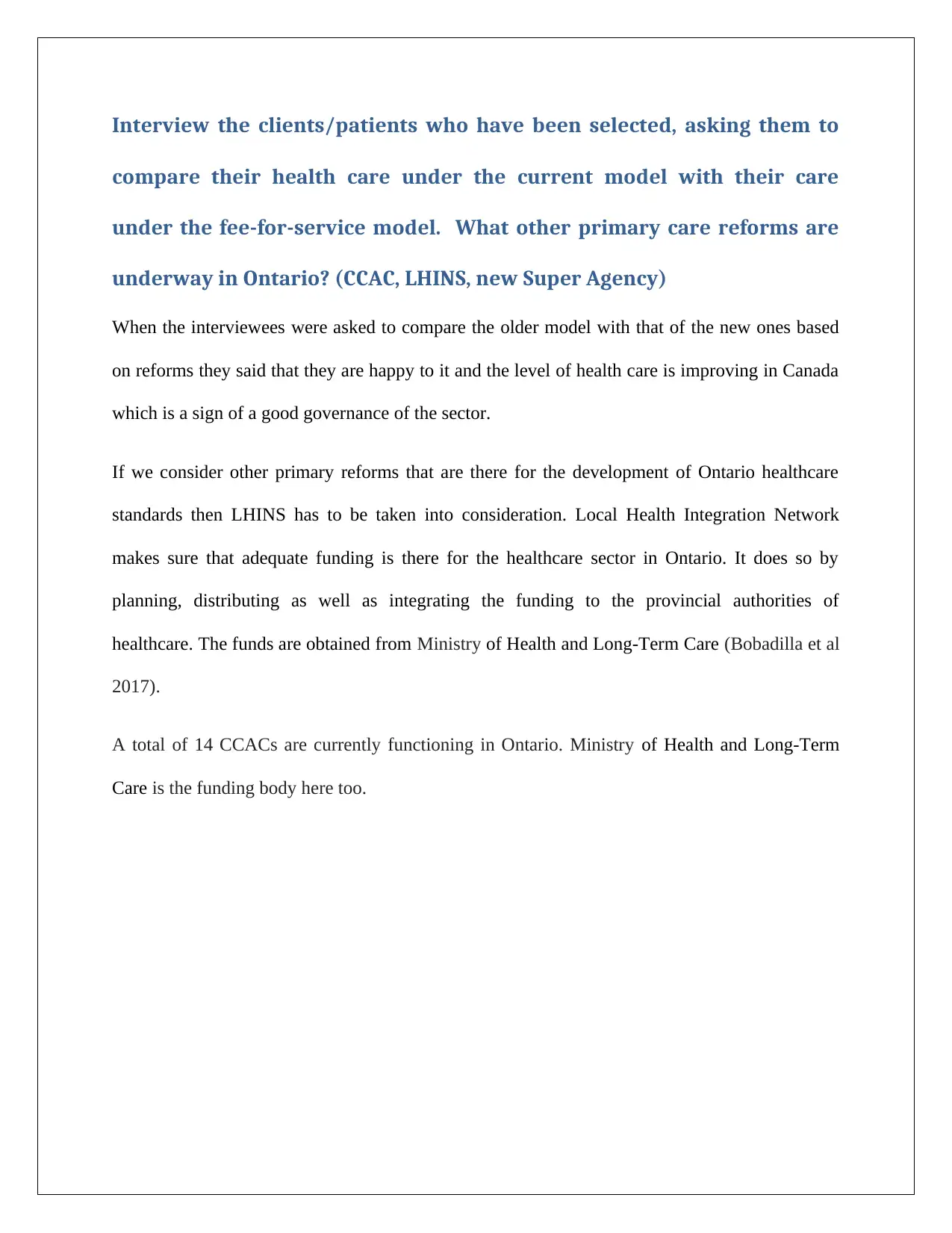
Interview the clients/patients who have been selected, asking them to
compare their health care under the current model with their care
under the fee-for-service model. What other primary care reforms are
underway in Ontario? (CCAC, LHINS, new Super Agency)
When the interviewees were asked to compare the older model with that of the new ones based
on reforms they said that they are happy to it and the level of health care is improving in Canada
which is a sign of a good governance of the sector.
If we consider other primary reforms that are there for the development of Ontario healthcare
standards then LHINS has to be taken into consideration. Local Health Integration Network
makes sure that adequate funding is there for the healthcare sector in Ontario. It does so by
planning, distributing as well as integrating the funding to the provincial authorities of
healthcare. The funds are obtained from Ministry of Health and Long-Term Care (Bobadilla et al
2017).
A total of 14 CCACs are currently functioning in Ontario. Ministry of Health and Long-Term
Care is the funding body here too.
compare their health care under the current model with their care
under the fee-for-service model. What other primary care reforms are
underway in Ontario? (CCAC, LHINS, new Super Agency)
When the interviewees were asked to compare the older model with that of the new ones based
on reforms they said that they are happy to it and the level of health care is improving in Canada
which is a sign of a good governance of the sector.
If we consider other primary reforms that are there for the development of Ontario healthcare
standards then LHINS has to be taken into consideration. Local Health Integration Network
makes sure that adequate funding is there for the healthcare sector in Ontario. It does so by
planning, distributing as well as integrating the funding to the provincial authorities of
healthcare. The funds are obtained from Ministry of Health and Long-Term Care (Bobadilla et al
2017).
A total of 14 CCACs are currently functioning in Ontario. Ministry of Health and Long-Term
Care is the funding body here too.
⊘ This is a preview!⊘
Do you want full access?
Subscribe today to unlock all pages.

Trusted by 1+ million students worldwide
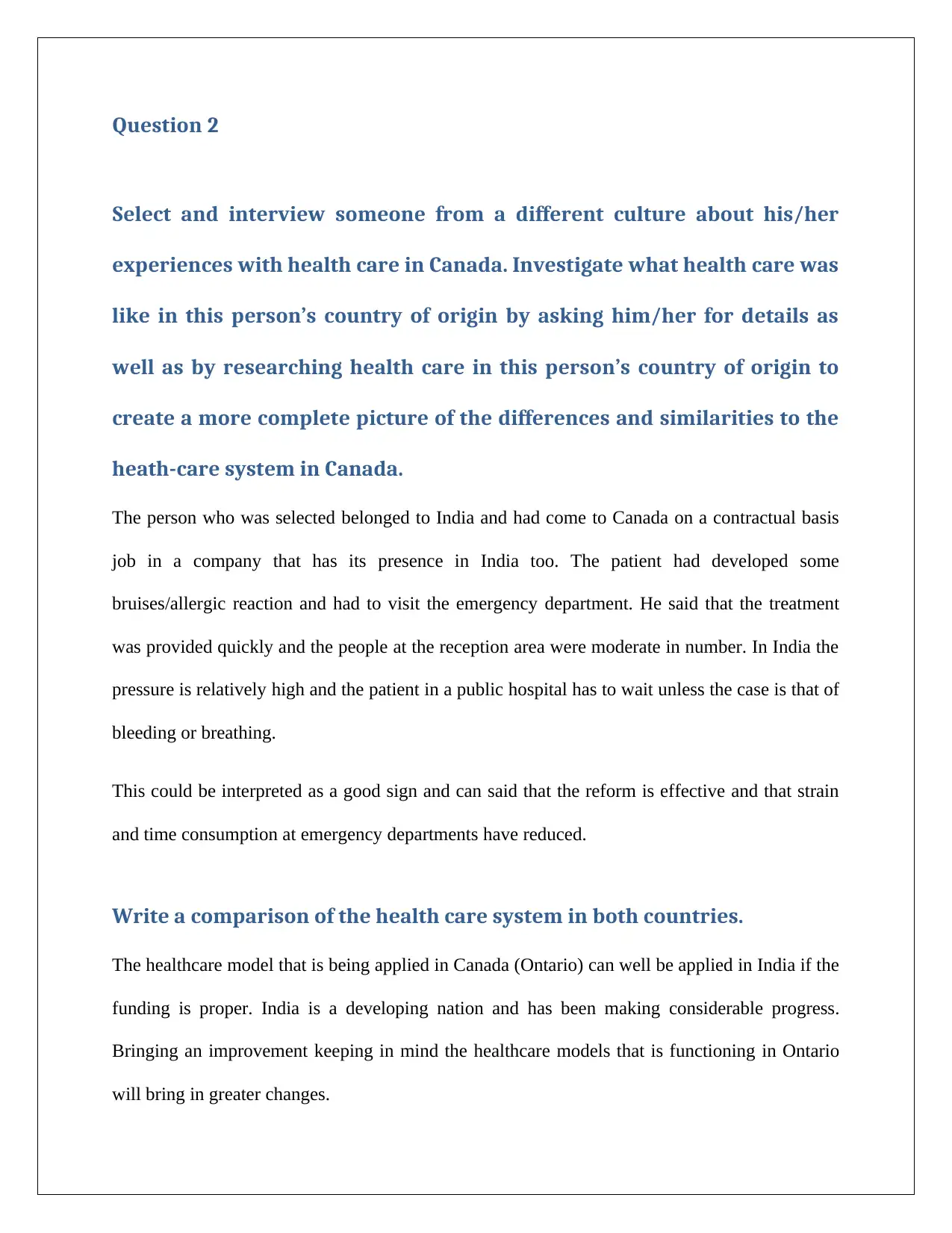
Question 2
Select and interview someone from a different culture about his/her
experiences with health care in Canada. Investigate what health care was
like in this person’s country of origin by asking him/her for details as
well as by researching health care in this person’s country of origin to
create a more complete picture of the differences and similarities to the
heath-care system in Canada.
The person who was selected belonged to India and had come to Canada on a contractual basis
job in a company that has its presence in India too. The patient had developed some
bruises/allergic reaction and had to visit the emergency department. He said that the treatment
was provided quickly and the people at the reception area were moderate in number. In India the
pressure is relatively high and the patient in a public hospital has to wait unless the case is that of
bleeding or breathing.
This could be interpreted as a good sign and can said that the reform is effective and that strain
and time consumption at emergency departments have reduced.
Write a comparison of the health care system in both countries.
The healthcare model that is being applied in Canada (Ontario) can well be applied in India if the
funding is proper. India is a developing nation and has been making considerable progress.
Bringing an improvement keeping in mind the healthcare models that is functioning in Ontario
will bring in greater changes.
Select and interview someone from a different culture about his/her
experiences with health care in Canada. Investigate what health care was
like in this person’s country of origin by asking him/her for details as
well as by researching health care in this person’s country of origin to
create a more complete picture of the differences and similarities to the
heath-care system in Canada.
The person who was selected belonged to India and had come to Canada on a contractual basis
job in a company that has its presence in India too. The patient had developed some
bruises/allergic reaction and had to visit the emergency department. He said that the treatment
was provided quickly and the people at the reception area were moderate in number. In India the
pressure is relatively high and the patient in a public hospital has to wait unless the case is that of
bleeding or breathing.
This could be interpreted as a good sign and can said that the reform is effective and that strain
and time consumption at emergency departments have reduced.
Write a comparison of the health care system in both countries.
The healthcare model that is being applied in Canada (Ontario) can well be applied in India if the
funding is proper. India is a developing nation and has been making considerable progress.
Bringing an improvement keeping in mind the healthcare models that is functioning in Ontario
will bring in greater changes.
Paraphrase This Document
Need a fresh take? Get an instant paraphrase of this document with our AI Paraphraser
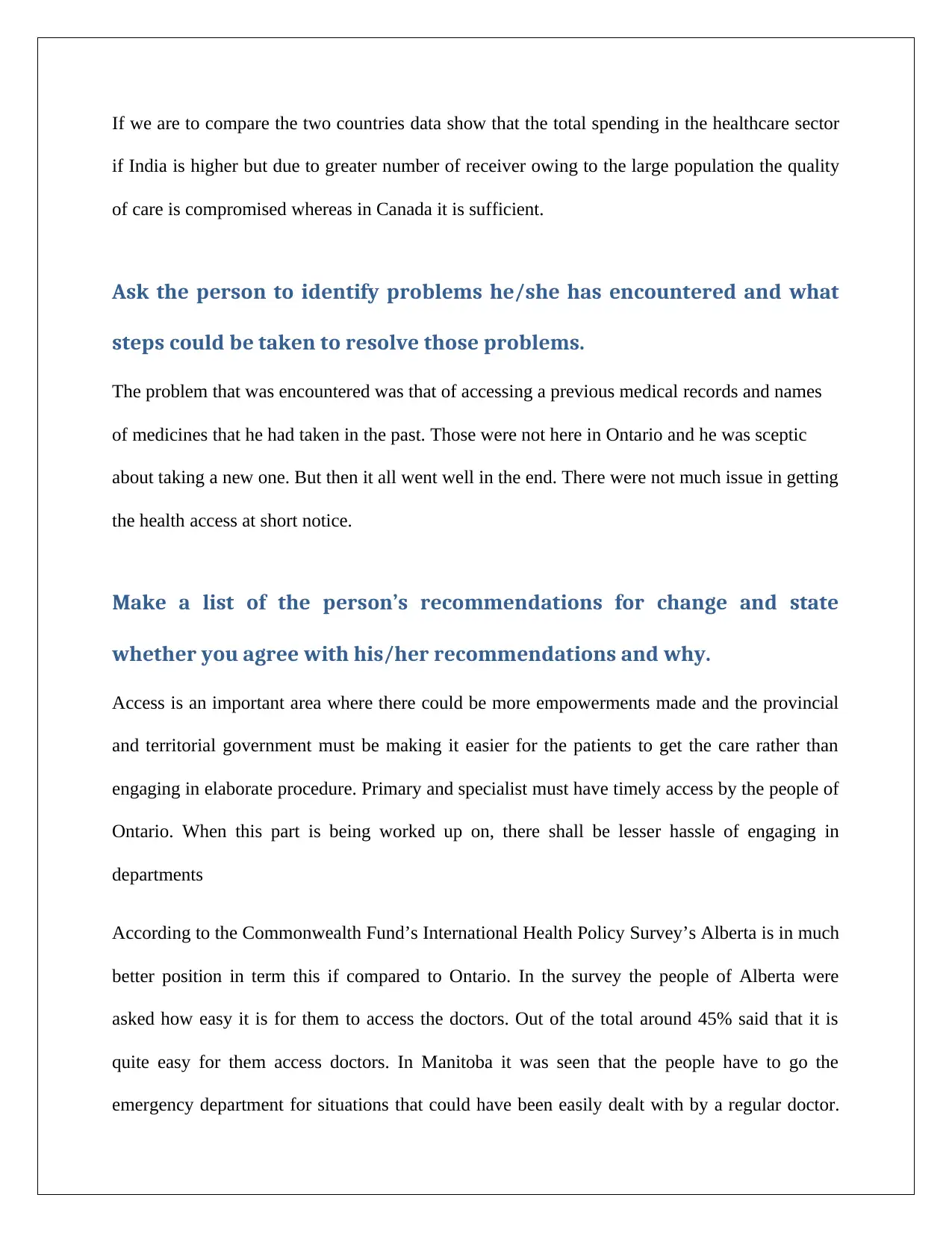
If we are to compare the two countries data show that the total spending in the healthcare sector
if India is higher but due to greater number of receiver owing to the large population the quality
of care is compromised whereas in Canada it is sufficient.
Ask the person to identify problems he/she has encountered and what
steps could be taken to resolve those problems.
The problem that was encountered was that of accessing a previous medical records and names
of medicines that he had taken in the past. Those were not here in Ontario and he was sceptic
about taking a new one. But then it all went well in the end. There were not much issue in getting
the health access at short notice.
Make a list of the person’s recommendations for change and state
whether you agree with his/her recommendations and why.
Access is an important area where there could be more empowerments made and the provincial
and territorial government must be making it easier for the patients to get the care rather than
engaging in elaborate procedure. Primary and specialist must have timely access by the people of
Ontario. When this part is being worked up on, there shall be lesser hassle of engaging in
departments
According to the Commonwealth Fund’s International Health Policy Survey’s Alberta is in much
better position in term this if compared to Ontario. In the survey the people of Alberta were
asked how easy it is for them to access the doctors. Out of the total around 45% said that it is
quite easy for them access doctors. In Manitoba it was seen that the people have to go the
emergency department for situations that could have been easily dealt with by a regular doctor.
if India is higher but due to greater number of receiver owing to the large population the quality
of care is compromised whereas in Canada it is sufficient.
Ask the person to identify problems he/she has encountered and what
steps could be taken to resolve those problems.
The problem that was encountered was that of accessing a previous medical records and names
of medicines that he had taken in the past. Those were not here in Ontario and he was sceptic
about taking a new one. But then it all went well in the end. There were not much issue in getting
the health access at short notice.
Make a list of the person’s recommendations for change and state
whether you agree with his/her recommendations and why.
Access is an important area where there could be more empowerments made and the provincial
and territorial government must be making it easier for the patients to get the care rather than
engaging in elaborate procedure. Primary and specialist must have timely access by the people of
Ontario. When this part is being worked up on, there shall be lesser hassle of engaging in
departments
According to the Commonwealth Fund’s International Health Policy Survey’s Alberta is in much
better position in term this if compared to Ontario. In the survey the people of Alberta were
asked how easy it is for them to access the doctors. Out of the total around 45% said that it is
quite easy for them access doctors. In Manitoba it was seen that the people have to go the
emergency department for situations that could have been easily dealt with by a regular doctor.
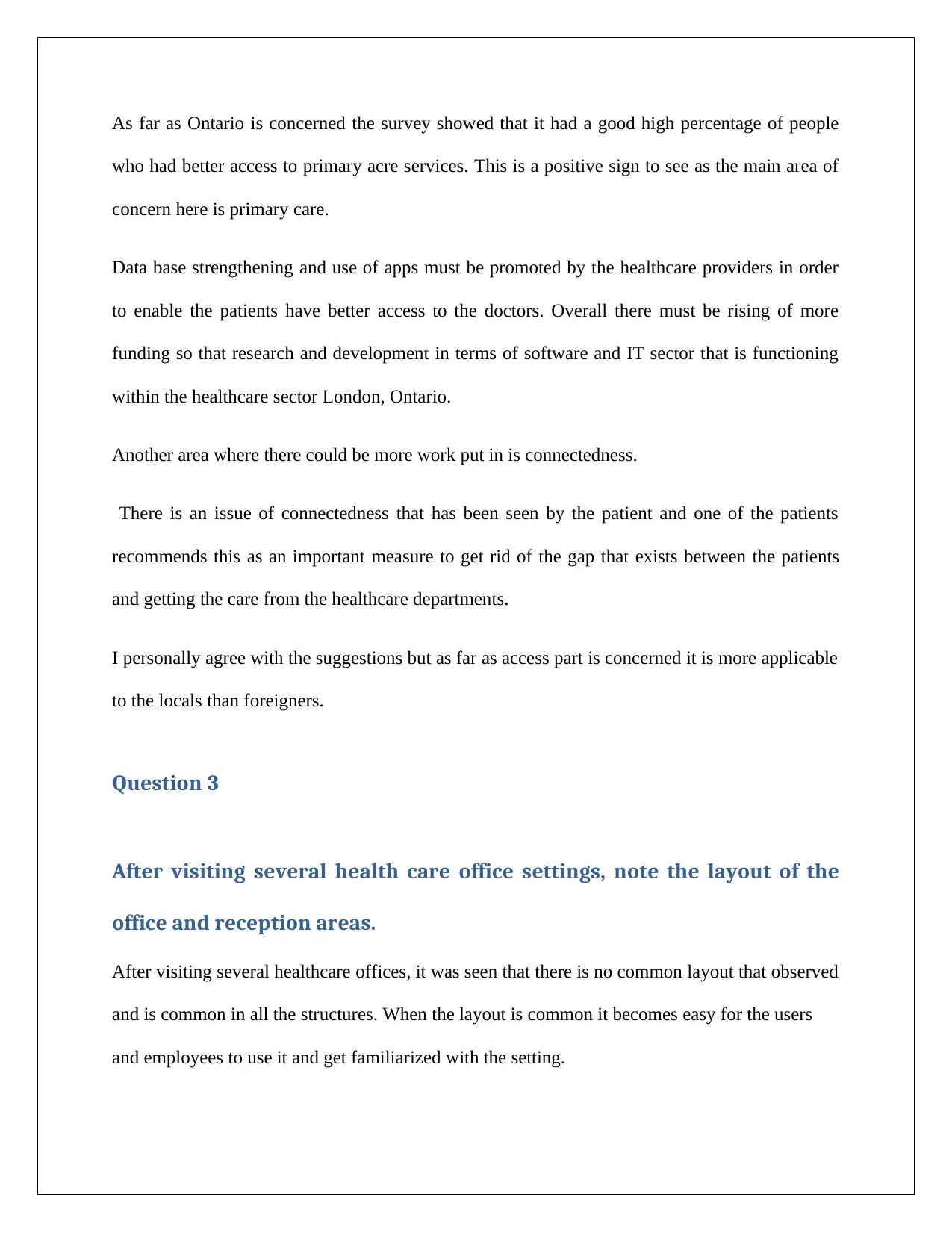
As far as Ontario is concerned the survey showed that it had a good high percentage of people
who had better access to primary acre services. This is a positive sign to see as the main area of
concern here is primary care.
Data base strengthening and use of apps must be promoted by the healthcare providers in order
to enable the patients have better access to the doctors. Overall there must be rising of more
funding so that research and development in terms of software and IT sector that is functioning
within the healthcare sector London, Ontario.
Another area where there could be more work put in is connectedness.
There is an issue of connectedness that has been seen by the patient and one of the patients
recommends this as an important measure to get rid of the gap that exists between the patients
and getting the care from the healthcare departments.
I personally agree with the suggestions but as far as access part is concerned it is more applicable
to the locals than foreigners.
Question 3
After visiting several health care office settings, note the layout of the
office and reception areas.
After visiting several healthcare offices, it was seen that there is no common layout that observed
and is common in all the structures. When the layout is common it becomes easy for the users
and employees to use it and get familiarized with the setting.
who had better access to primary acre services. This is a positive sign to see as the main area of
concern here is primary care.
Data base strengthening and use of apps must be promoted by the healthcare providers in order
to enable the patients have better access to the doctors. Overall there must be rising of more
funding so that research and development in terms of software and IT sector that is functioning
within the healthcare sector London, Ontario.
Another area where there could be more work put in is connectedness.
There is an issue of connectedness that has been seen by the patient and one of the patients
recommends this as an important measure to get rid of the gap that exists between the patients
and getting the care from the healthcare departments.
I personally agree with the suggestions but as far as access part is concerned it is more applicable
to the locals than foreigners.
Question 3
After visiting several health care office settings, note the layout of the
office and reception areas.
After visiting several healthcare offices, it was seen that there is no common layout that observed
and is common in all the structures. When the layout is common it becomes easy for the users
and employees to use it and get familiarized with the setting.
⊘ This is a preview!⊘
Do you want full access?
Subscribe today to unlock all pages.

Trusted by 1+ million students worldwide
1 out of 26
Related Documents
Your All-in-One AI-Powered Toolkit for Academic Success.
+13062052269
info@desklib.com
Available 24*7 on WhatsApp / Email
![[object Object]](/_next/static/media/star-bottom.7253800d.svg)
Unlock your academic potential
Copyright © 2020–2025 A2Z Services. All Rights Reserved. Developed and managed by ZUCOL.





